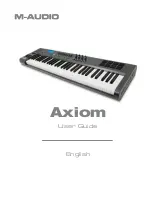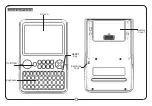
Triple Modular Processing
Editing Triples
12-11
In order to function as designed, DSP blocks that use NOISE+ must be followed immediately by
one of the DSP functions listed below. Otherwise, you won’t be able to attenuate the level of the
added noise. If you use NOISE+ in the
last
DSP block of a Layer-2 algorithm, the
fi
rst
DSP block
of Layer 3’s algorithm must be one of these functions.
Exploring the Possibilities
You may never exhaust the possible combinations of DSP functions available with triple-
modular processing, but keep experimenting. We’ve found that using simple waveforms when
trying different DSP functions makes it easier to hear the effects of each function. Try using
SINE, SQR, and SAW in various DSP blocks. These block all incoming audio signals and
generate a simple waveform as output (as opposed to SINE+, SQR+, and SAW+, which add
waveforms to the existing signal).
NONE
+AMP
AMP
+GAIN
PANNER
XFADE
BAL AMP
Summary of Contents for K2661
Page 18: ...2 4 LFOs LFO Shapes...
Page 34: ...3 16 DSP Algorithms...
Page 54: ...5 4 MIDI Note Numbers Note Numbers for Percussion Keymaps...
Page 72: ...7 10 System Exclusive Protocol K2661 System Exclusive Implementation...
Page 82: ...9 4 Upgrading Sample Memory Choosing and Installing a SIMM for K2661 Sample Memory...
Page 334: ...10 252 KDFX Reference KDFX Algorithm Specifications...
Page 340: ...11 6 Glossary...
Page 382: ...12 42 Triple Modular Processing Alphanumeric Buttonpad Entries for DSP Functions...
Page 392: ...B 6 SysEx Control of KDFX MSB and LSB...
Page 442: ...D 20 Contemporary ROM Block Objects Controller Assignments Contemporary ROM Block...
Page 490: ...H 12 General MIDI Standard Mode Controller Assignments...
Page 492: ...I 2 Live Mode Objects Live Mode Programs...
Page 498: ...K2661 Musician s Reference Index...
Page 500: ......
















































